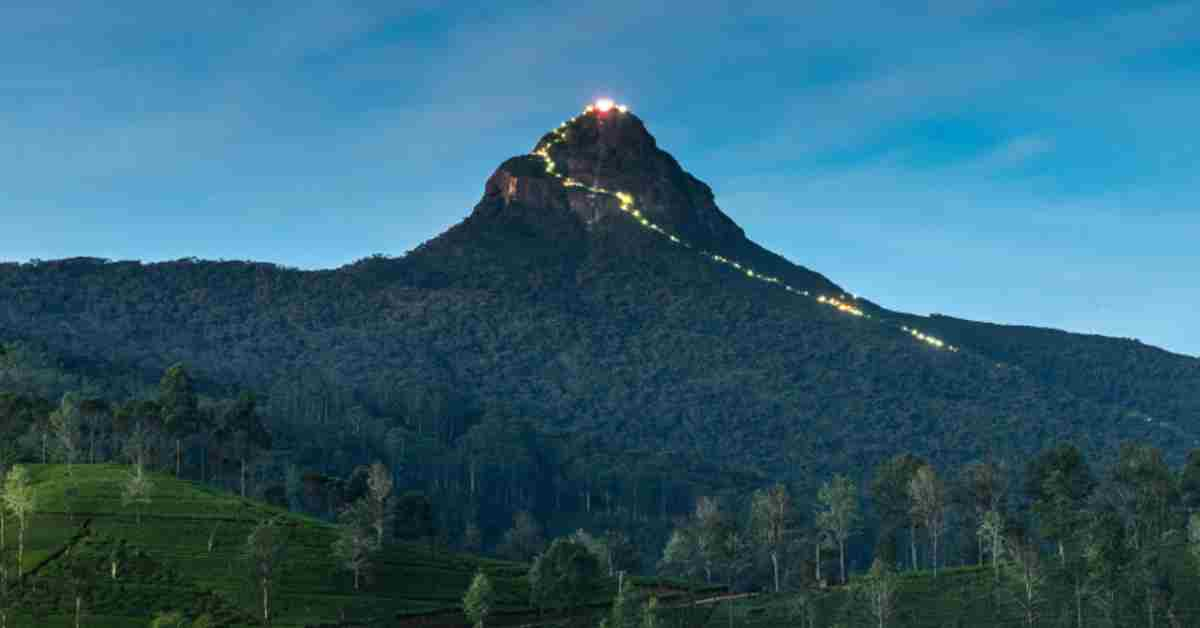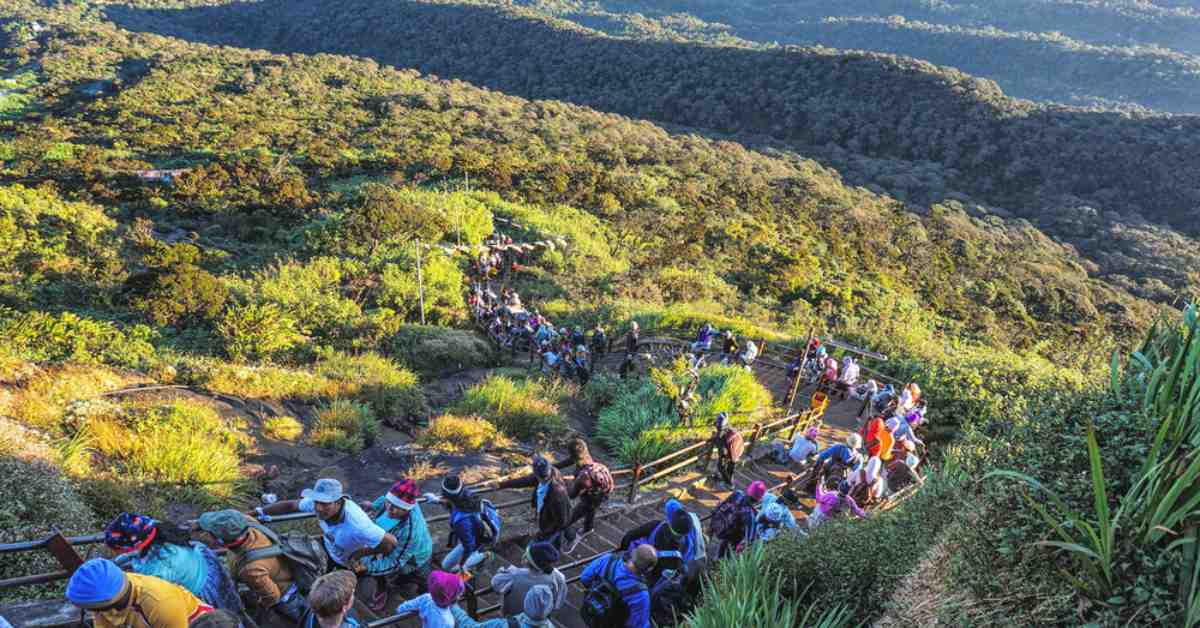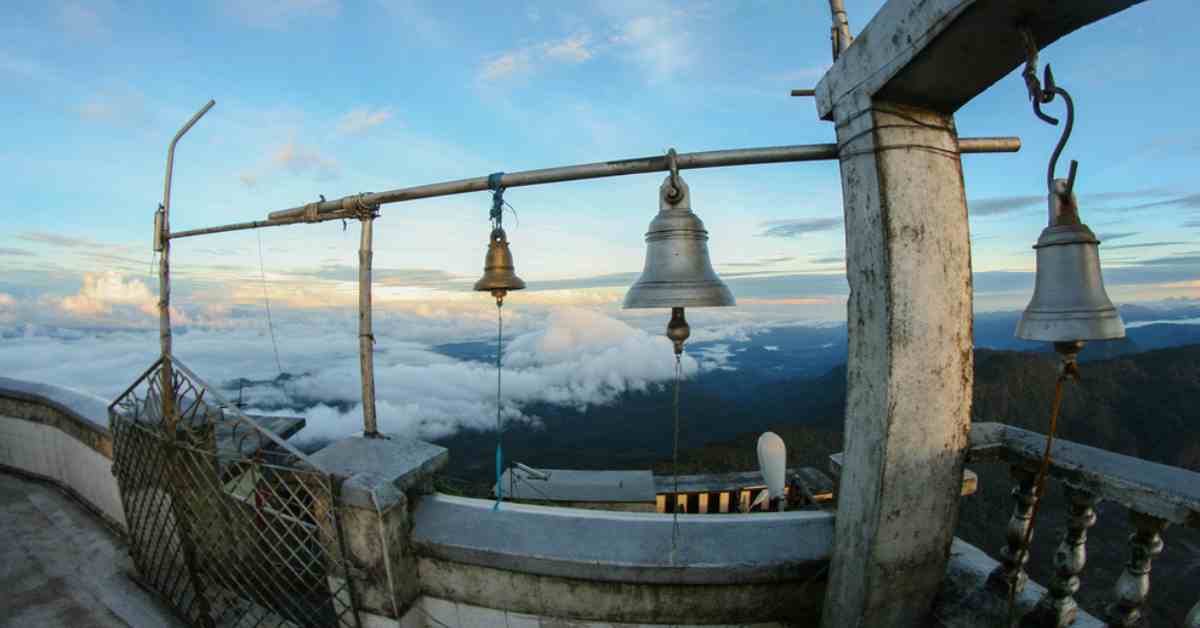
Adam’s Peak, also known as Sri Pada, is a sacred mountain in the heart of Sri Lanka. It is a pilgrimage site for many Buddhists, Hindus, and Christians who believe climbing the mountain brings spiritual benefits. The Peak stands at 2,243 meters (7,359 feet) tall and boasts stunning views of the surrounding landscape. This article will examine the history, significance, and logistics of climbing Adam’s Peak.
Table of Contents
History and Significance of Adam’s Peak
Adam’s Peak has a rich history dating back to ancient times. It is believed that the footprint at the summit is that of the Buddha, and it is also considered the place where Adam first set foot on Earth after being cast out of heaven. This is why it is called Adam’s Peak. For centuries, people have been pilgrimaging the summit of Adam’s Peak to pay homage to the sacred footprint.
The pilgrimage season begins in December and ends in May, coinciding with the dry season in Sri Lanka. During this time, the mountain is illuminated with colourful lights, and thousands of pilgrims flock to climb the hill.
Nomenclature
It is referred to by several names, each with its unique meaning. However, Sri Pada is one of the most common names. It is a Sanskrit-based language that the Sinhalese primarily use in religious contexts. The name translates to “the sacred foot” and is linked to the footprint-shaped mark at the summit. According to Buddhist belief, this footprint belongs to the Buddha.
However, some Christian and Islamic traditions associate the footprint with Adam, who left it when he first set foot on Earth after being cast out of paradise. This has given rise to the name “Adam’s Peak” in these traditions.
Hindu tradition also associates the footprint with a deity, referring to the mountain as Shiva padam (Shiva’s foot) in Tamil. The community of Tamils may also use the term Shivanolipatha Malai to refer to the hill.
Another name for the mountain in Sinhala is Samanalakanda, which refers to the deity Saman or the butterflies (samanalayā) that migrate to the region annually. However, Sri Pada is the most commonly used name for the mountain.
Best Time to Climb
The best time to climb Adam’s Peak depends on the weather conditions and the pilgrimage season. The pilgrimage season starts in December and ends in May when the temple at the summit is open and fully operational. Therefore, it is best to climb during this period.
The weather conditions also play a crucial role in determining the best climbing time. The ideal period is from December to February, when the weather is usually dry and cool. However, keep in mind that these are also the busiest months with the most number of pilgrims. Therefore, starting the climb early in the morning is advisable to avoid the crowd and the heat.
During the off-season (June to November), climbing is possible but challenging due to the monsoon season. Heavy rain and strong winds can make the climb difficult and even dangerous. The temple at the summit is also closed during this time, so there is only a point in climbing if you are interested in experiencing the beauty of the mountain in its natural form.
Fitness Level
While attempting the ascent of Adam’s Peak, physical fitness is a vital consideration. All ages can accomplish the climb. However, it does demand a certain level of physical fitness. The journey consists of a challenging trek up hundreds of stairs, which may be taxing on the legs and lungs. Therefore, before tackling the climb, it is advised that climbers be in excellent health and possess a minimum degree of fitness.
In the weeks preceding the climb, it is advisable to participate in regular activity, such as walking or running. This will enhance cardiovascular health and stamina, making the ascent more straightforward. Pre- and post-climb stretching is also suggested to prevent damage.
Listening to your body and resting as needed is essential throughout the ascent. While rushing the climb might result in tiredness or damage, climbers are recommended to ascend at a measured pace. Maintaining hydration throughout the rise is also essential by packing sufficient water or purchasing it at rest breaks.
Ultimately, although a certain level of physical condition is necessary, individuals of all ages and fitness levels can accomplish the ascent of Adam’s Peak with careful planning and timing.
What to Bring
While preparing for the e climb to Adam’s Peak, it is essential to pack carefully and carry the required items for a pleasant and safe expedition. These are some critical items to consider packing:
Appropriate footwear: To minimise slips and falls on steep and uneven terrain, it is advised to wear comfortable and robust footwear, such as hiking boots or sneakers.
Warm clothing: Although temperatures can drop dramatically at higher altitudes, it is vital to wear warm clothing such as coats, gloves, and caps to protect against the e cold.
Water: Keeping hydrated throughout the climb is critical, so carry adequate water. Bottled water is available for purchase along the way. However, it is advised that you have a refillable water bottle.
Snacks: Energy-boosting snacks like nuts, fruits, and energy bars can help climbers stay fuelled through the ascent.
Flashlight/headlamp: A flashlight or headlamp is required for vision on the dimly lit route because the climb may be done at night.
Basic First Aid Kit: Carrying a basic first aid kit that includes bandages, disinfectant, and pain medications might be helpful in minor injuries.
Rain Gear: Because the weather may be unpredictable, wearing a raincoat or poncho might assist in protecting against rain or unexpected showers.
Personal items: Other personal items, such as sunscreen, bug repellent, and a camera, are suggested to improve the experience.
Climbers may ensure a safe and pleasurable ascent to Adam’s Peak’s summit by correctly packing and carrying the required items.
Starting Points
When planning to climb Adam’s Peak in Sri Lanka, there are six different starting points or trails to choose from.
Starting Points
When planning to climb Adam’s Peak in Sri Lanka, there are six different starting points or trails to choose from.
Ratnapura-Palabaddala: The Ratnapura-Palabaddala trail is one of the six starting points for climbing Adam’s Peak. Many climbers favour it due to its accessibility by bus from major cities or towns. The Trail begins in Ratnapura and passes through the village of Palabaddala before reaching the starting point of the climb. This Trail offers stunning views of the surrounding landscape, including waterfalls and tea plantations.
Hatton-Nallathanni: The Hatton-Nallathanni trail is another popular starting point for climbing Adam’s Peak. This Trail begins in Hatton and passes through the village of Nallathanni before reaching the starting point of the climb. While this route is steeper than other trails, it is also the shortest, saving climbers about five kilometres of walking distance. This Trail also offers beautiful views of the surrounding mountains and valleys.
Kuruwita-Erathna: The Kuruwita-Erathna trail is less frequently used than the Nallathanni and Palabaddala routes, but it is still a viable option for climbers. This Trail begins in Kuruwita and passes through the village of Erathna before reaching the starting point of the climb. This route is longer and more challenging than other trails but offers stunning views of the surrounding forests and waterfalls.
Murraywatte: The Murraywatte trail is one of the less popular starting points for climbing Adam’s Peak. This Trail begins in the village of Murraywatte and intersects with the Palabaddala road midway through the ascent. While this route is not used as frequently as other trails, it still offers beautiful views of the surrounding mountains and forests.
Mookuwatte: The Mookuwatte trail is another less popular starting point for climbing Adam’s Peak. This Trail begins in the village of Mookuwatte and also intersects with the Palabaddala road midway through the ascent. While this route is less commonly used than other trails, it still offers beautiful views of the surrounding forests and valleys.
Malimboda: The Malimboda trail is the least frequently used starting point for climbing Adam’s Peak. This Trail begins in the village of Malimboda and also intersects with the Palabaddala road midway through the ascent. While climbers do not commonly use this route, it offers stunning views of the surrounding mountains and valleys for those who choose to take it.
The Climb
The climb to the summit of Adam’s Peak depends on several factors, such as the chosen Trail, fitness level, weather conditions, and the number of breaks taken. As mentioned, there are six trails to choose from, with the Nallathanni and Palabaddala routes being the most popular. The ascent via Hatton is the steepest and shortest, while the Kuruwita-Erathna trail is less commonly used.
A good fitness level before climbing is essential as it involves climbing several thousand steps. Rest and hydration are necessary to avoid exhaustion and dehydration during the climb. It’s also crucial to check the weather forecast before starting the ascent, as rain can make the Trail slippery and dangerous. It’s best to avoid climbing during the rainy season from May to October.
Taking regular breaks during the climb is also crucial. Rest stops and wayside shops along the trails serve refreshments and supplies, allowing climbers to rest and refuel before continuing. Climbers should also listen to their bodies and take breaks whenever they feel tired or need to catch their breath.
In general, climbing Adam’s Peak requires moderate fitness, proper planning, and careful attention to one’s body’s needs. However, with appropriate preparation, climbers can reach the summit and experience this remarkable mountain’s stunning views and spiritual significance.
The Summit
The summit of Adam’s Peak, also known as Sri Pada, is a sacred site for Buddhists, Hindus, Christians, and Muslims. At the Peak, there is a depression in the shape of a footprint, which is believed to be that of Lord Buddha by Buddhists, Lord Shiva by Hindus, Adam by Christians, and Hazrat Adam by Muslims. This footprint is approximately five feet long and is covered with a gold plate. A low wall surrounds the depression, and it is customary for pilgrims to walk around it three times and make offerings of flowers and incense.
Besides the footprint is a small Buddhist temple at the summit, which houses a statue of Lord Buddha and a few other figures. The temple is believed to have been built in the 11th century and has undergone several renovations. It is a popular destination for pilgrims who pay their respects and seek blessings.
The summit of Adam’s Peak offers spectacular views of the surrounding hills and valleys. The scenery is breathtaking at dawn as the rising sun casts a golden glow. Many pilgrims make the ascent in the early morning hours to witness this stunning sight. The climate at the summit is cool and often misty, and pilgrims are advised to carry warm clothing to protect themselves from the chilly winds.
Summary
Adam’s Peak, also known as Sri Pada, is a sacred peak with religious and cultural importance for many religions. With six beginning places or pathways to choose from, climbing the e mountain is a well-liked pilgrimage and tourism activity. Depending on one’s physical level and the weather, the e climb might be challenging. There are rest areas, rest stops, and convenience stores along the trails to supply refreshments and supplies. Warm clothing, comfortable shoes, and a flashlight are critical pieces of gear that must be provided. The most significant time to climb is during the e pilgrimage season, which usually lasts from December through May.
In addition to being a physical experience, visiting Adam’s Peak is spiritual. The climb may be a moment for introspection and contemplation and an opportunity to appreciate the natural beauty of the surrounding environment. For religious or personal reasons, ascending Adam’s Peak is a once-in-a-lifetime opportunity.
FAQs and Answers
Adam’s Peak is 2,243 meters (7,359 feet) above sea level.
The best time to climb Adam’s Peak is from December to April when the weather is usually clear and dry.
It typically takes 3-5 hours to climb to the summit, depending on the Trail and fitness level.
Climbing Adam’s Peak can be challenging, especially for those not used to hiking or trekking. However, it is doable with proper preparation and training.
It is recommended to wear comfortable and breathable clothing, such as hiking pants and a moisture-wicking shirt. Proper hiking shoes with good traction are also important.
Hiring a guide is unnecessary, but it can be helpful, especially for first-time climbers. Guides can provide valuable information about the Trail and help ensure safety.
Yes, climbing Adam’s Peak is generally safe if proper safety precautions are taken. However, knowing about weather conditions and following the trail rules is essential.
Climbing Adam’s Peak alone is possible, but hiking with a partner or group is always recommended for safety reasons.
Yes, children can climb Adam’s Peak, but it is recommended for children above the age of 7 due to the length and steepness of the climb.
Yes, there are rest stops and wayside shops along the Trail where climbers can take a break and buy refreshments and supplies.
It is possible to climb Adam’s Peak at night, a popular option, especially during peak season. The Trail is illuminated with electric lights.
Buddhists believe the footprint at the summit to be that of the Buddha. However, some Christian and Islamic traditions assert that it is the footprint of Adam.
No, camping is not allowed at the summit of Adam’s Peak.
No, there are no fees to climb Adam’s Peak, but donations to the temple at the summit are appreciated.
It is recommended to bring your food and drinks for the climb, especially if you have specific dietary requirements
There are some wildlife concerns on the Trail, such as leeches and monkeys. Awareness of safety problems such as slippery or uneven terrain is also essential.
The most popular Trail to climb Adam’s Peak is the Hatton-Nallathanni trail, the steepest but the shortest.
It is possible to climb Adam’s Peak during the off-season, but it may not be as convenient as during the peak season.



